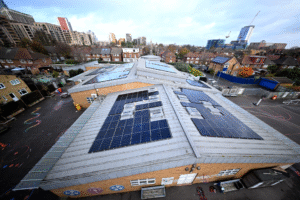New research shows more than half of extreme weather events are not covered by insurance, costing the economy billions. But there are measures to mitigate some of that risk.
In 2022, extreme weather is thought to have cost the global economy £249billion. However, just £105billion of this was covered by insurance policies – or 42%.
The study into the effects of storms, floods, snow, droughts, and other climactic disturbances on small and midsize enterprises (SMEs) by business insurance experts Uswitch looked at cost, insurance payouts, and eligibility to make a claim.
Looking at the UK, where flooding is often considered the greatest and most widely ‘distributed’ threat from climate change, one-in-three businesses are considered to be at risk, and of those which have suffered flooding, the average cost was £82,000. The average small business could lose up to 50 working days as a result of these events, which come with hefty price tags. The 2007 floods, for example, cost the British economy £4billion.
USwitch’s Andy Elder has shared 10 factors organisations and leaders must consider when looking for protection from extreme weather.
Insurance Coverage
‘Having insurance against these sorts of events is one of the most important ways to ensure your business is protected from unforeseen events. If you needprotection against various types of extreme weather, such as floods, hurricanes, earthquakes, or wildfires, consider investing in a comprehensive insurance policy that covers this. Make sure you review your policy regularly to ensure it adequately covers potential risks.’
Risk Assessment and Planning
‘Failing to prepare is preparing to fail, so it’s a good idea to conduct a thorough risk assessment to identify potential extreme weather risks in your area. This enables you to develop a disaster recovery plan that outlines procedures to mitigate these risks and ensures business continuity.’
Backup Data and Systems
‘Implement regular data backups and store them offsite or in the cloud. This ensures that even if your physical premises are damaged, critical business data can be recovered, allowing operations to resume quickly.’
Secure Facilities and Infrastructure
‘Retrofit your business premises to withstand potential extreme weather events. This may involve reinforcing structures, installing storm shutters, or securing heavy equipment to prevent damage during earthquakes or floods.’
Emergency Preparedness Training
‘Train employees on emergency procedures and protocols to follow during extreme weather events. Conduct regular drills to ensure everyone knows their roles and responsibilities in case of an emergency.’
Communication Plans
‘Establish communication channels to stay connected with employees, customers, suppliers, and other stakeholders during and after an extreme weather event. Utilise multiple modes of communication, such as email, phone, text messages, and social media.’
Alternative Work Arrangements
‘Develop remote work capabilities to allow employees to continue working from home if access to the physical workspace is restricted due to extreme weather. Ensure that necessary tools and resources are accessible remotely.’
Supply Chain Diversification
‘Diversify your supply chain by sourcing materials and components from multiple suppliers located in different regions. This reduces the risk of disruptions caused by extreme weather affecting a single supplier or region.’
Emergency Supplies and Resources
‘Maintain an emergency supply kit stocked with essential items such as food, water, first aid supplies, flashlights, batteries, and generators. This ensures that employees have the necessary resources to sustain themselves during and after a disaster.’
Community Engagement and Partnerships
‘Build relationships with local emergency responders, community organisations, and neighbouring businesses. Collaborate on disaster preparedness initiatives and share resources to enhance resilience and recovery efforts within the community.’
Image: Dylan Leagh
More on climate change:
UK Government must publish more than biodiversity ‘wish list’ this week
















